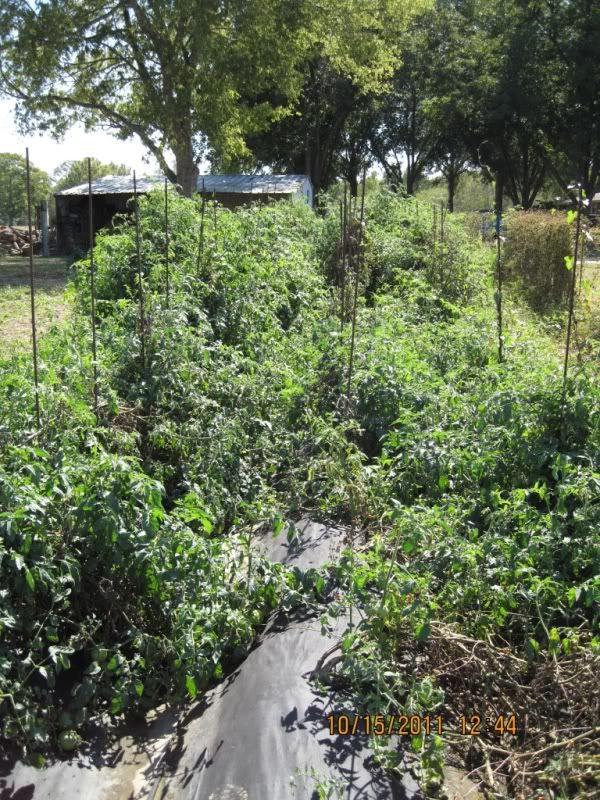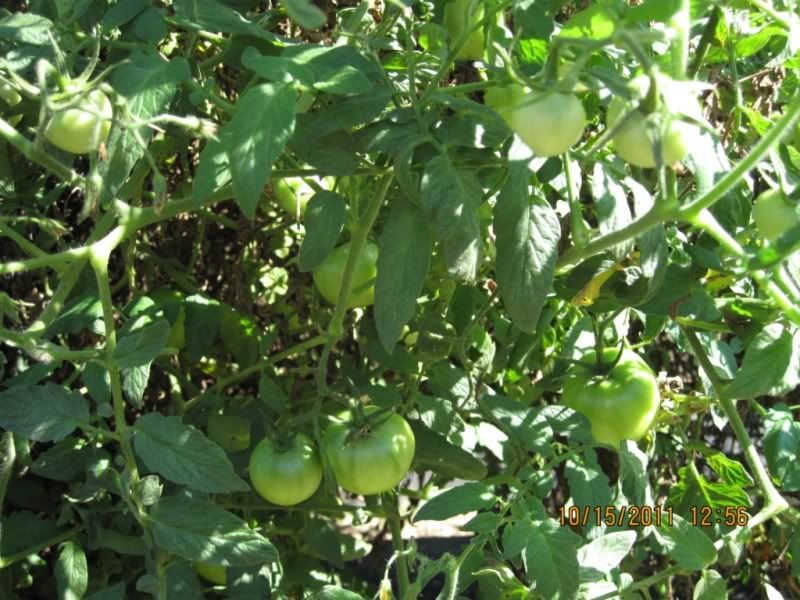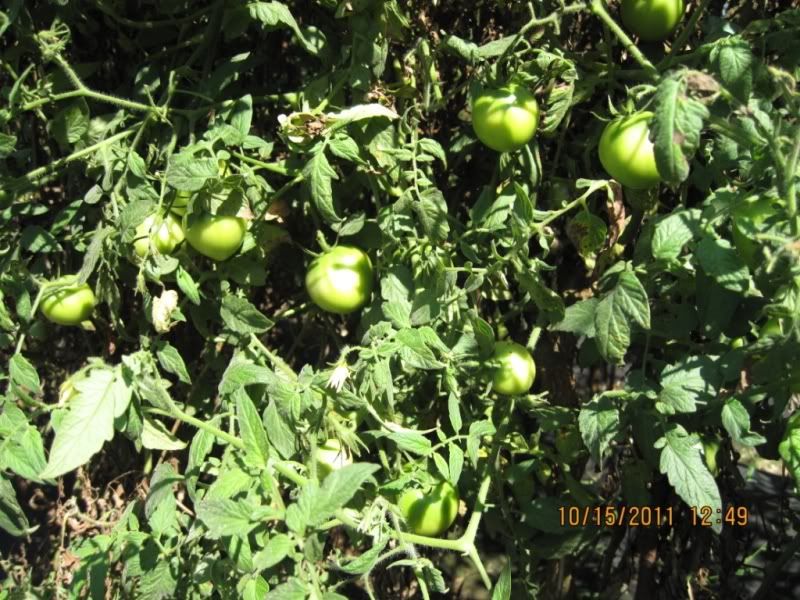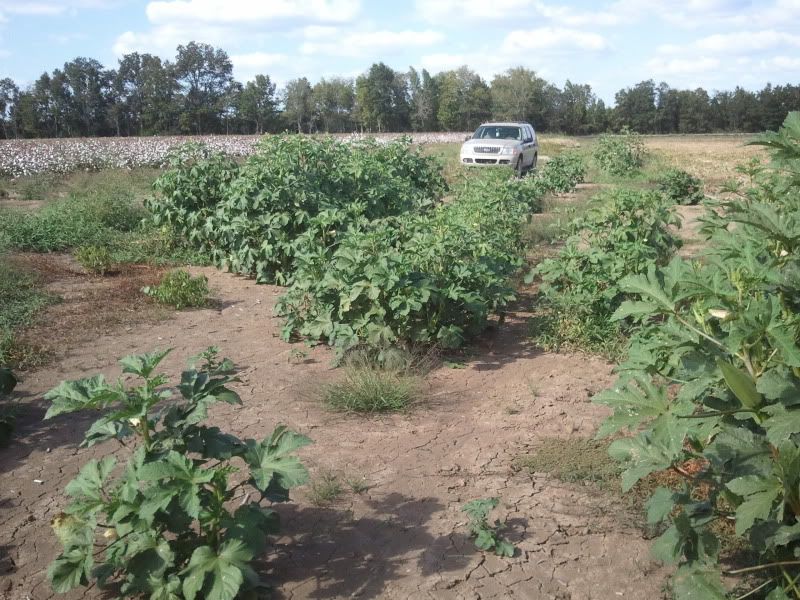Skip to comments.
Weekly Gardening Thread – 2011 (Vol. 40) October 14
Free Republic
| 10-14-2011
| Red_Devil 232
Posted on 10/14/2011 5:20:03 AM PDT by Red_Devil 232
Good morning gardeners. The October weather here in East Central Mississippi has been nothing but amazing this past week. We have had a few rainy days that have helped keep my compost pile moist as I am still working on building it up. It is satisfying to see the steam rise from it when I give it a turn on these cool mornings.
If you are a gardener or you are just starting out and are in need of advice or just encouragement please feel free to join in and enjoy the friendly discussion. Our Freeper community is full of gardeners, each with varying interests and skill levels from Master Gardener to novice.
I hope all your Summer gardens did well this year and your Fall gardens prosper.
TOPICS: Agriculture; Food; Gardening; Hobbies
KEYWORDS: garden; gardening; recipes; weekly
Navigation: use the links below to view more comments.
first previous 1-20, 21-40, 41-60, 61-72 next last
To: JustaDumbBlonde
That is a recipe to drool over!
Thanx!
41
posted on
10/15/2011 1:01:26 PM PDT
by
Sarajevo
(Is it true that cannibals don't eat clowns because they taste funny?)
To: satan69
"I also have to put lime on it 2 or 3 times a season as the rains wash it all away and the tomatoes get blossom end rot."You can apply your calcium in a foliar feed and it won't wash away.
42
posted on
10/15/2011 1:02:39 PM PDT
by
JustaDumbBlonde
(Don't wish doom on your enemies. Plan it.)
To: Sarajevo
It is a good basic syrup recipe that can be used for so many veggies to pickle. My husband likes okra pickled in that recipe.
43
posted on
10/15/2011 1:08:23 PM PDT
by
JustaDumbBlonde
(Don't wish doom on your enemies. Plan it.)
To: Red_Devil 232; tubebender; All
The tomato section of my garden looks like a jungle and, in fact, it is difficult to get in between the 4 rows. Heck, it's difficult to see that there are 4 rows! LOL
Anyway, when you get beneath the outward jungle appearance, there are bushels of green tomatoes! Some are large enough that they will certainly ripen before it gets cool, but there will be more than enough green tomatoes to make my DH's favorite relish to enjoy throughout the winter.





44
posted on
10/15/2011 1:26:08 PM PDT
by
JustaDumbBlonde
(Don't wish doom on your enemies. Plan it.)
To: JustaDumbBlonde
45
posted on
10/15/2011 3:23:59 PM PDT
by
tubebender
(She was only a whiskey maker, but I loved her still.)
To: JustaDumbBlonde
I thought Cotton came from the fabric store?
Just Kidding. I have never seen plants that uniform in height but I left the farm in 1951. My dad leased a place in 1946 or 47 and some of his plants were 5 feet tall. Of course we picked by hand in those days and we got over 3.5 bales on a few acres and averaged about 2 bales...
46
posted on
10/15/2011 3:33:20 PM PDT
by
tubebender
(She was only a whiskey maker, but I loved her still.)
To: tubebender
The growth regulators that we apply to cotton these days really flattens out the top of a field. I wish we could pick some 3.5 bale cotton! We could retire in a couple of years, but then if my DH was growing 3.5 bale cotton, he would keep right on farming. It is either a passion or a mental illness ... hard to tell which. :)
47
posted on
10/15/2011 4:08:16 PM PDT
by
JustaDumbBlonde
(Don't wish doom on your enemies. Plan it.)
To: JustaDumbBlonde
48
posted on
10/15/2011 5:51:40 PM PDT
by
tubebender
(She was only a whiskey maker, but I loved her still.)
To: tubebender
49
posted on
10/15/2011 7:07:35 PM PDT
by
JustaDumbBlonde
(Don't wish doom on your enemies. Plan it.)
To: JustaDumbBlonde
50
posted on
10/15/2011 8:02:44 PM PDT
by
cherry
To: cherry
51
posted on
10/16/2011 7:54:23 AM PDT
by
JustaDumbBlonde
(Don't wish doom on your enemies. Plan it.)
To: tubebender; Red_Devil 232; All
Had to share this with y'all, because it was so weird. I'm going down the edge of one of our cotton fields and I see plants that look just like okra. I get out of the vehicle to investigate and it is okra, but not like any I had ever seen before. The pods were 2-3 times as fat and shorter than any okra we've ever known.
So, I picked some of it and brought it home. Cut into it ... still looks like okra ... so I breaded and fried it. Tasted great.
DH and I have called everyone we can think of -- LSU extension office, old timers, other farmers -- to try to find out something about these unusual okra plants found in a very unusual place.
It isn't difficult to figure out how the plants came to grow where we found them. Obviously it was deer or bear that had eaten the okra somewhere and deposited it on the turn row. There are so many critter tracks around the farm, that it would be impossible to tell for sure. Coyotes are an outside chance, since they will eat almost anything if hungry enough.
Best guess so far is that the okra that was eaten by the animal was a hybrid and the resulting plants we found were throwbacks of some kind. The plants are big, strong and very pretty and definitely not spineless. These plants will leave you itching and stinging worse than any okra I've ever picked. I had to wear long sleeves, pants and gloves to get near the plants.
Since we cut the okra in the garden down weeks ago, we were very grateful for this gift from nature!


52
posted on
10/16/2011 9:26:28 AM PDT
by
JustaDumbBlonde
(Don't wish doom on your enemies. Plan it.)
To: JustaDumbBlonde
Forgot to mention that I saved many pods of seeds from the ‘wild’ okra, so that I could grow some next year. If anybody else wants to try some, let me know. I’ve got plenty of seeds to share.
53
posted on
10/16/2011 9:29:41 AM PDT
by
JustaDumbBlonde
(Don't wish doom on your enemies. Plan it.)
To: JustaDumbBlonde
Is it possible to trace the linage of your HyBrid from your main garden? It’s too cool to grow Okra here in Benderville, thank goodness
54
posted on
10/16/2011 12:05:51 PM PDT
by
tubebender
(She was only a whiskey maker, but I loved her still.)
To: tubebender
I didn't plant any hybrid varieties of okra, and there are no deer or bear in my garden. I'm not aware of a garden anywhere near the field where we found the okra.
My initial reaction to finding the okra was trying to tie it to the cotton field, since cotton is a relative of okra. But that is far-fetched, and there were no okra plants found IN the cotton field, only on the turn row between the cotton and what was a corn field earlier in the year.
Nobody we've contacted has ever seen a relatively short, extremely large diameter, pod of okra. Some of these pods resemble short ears of corn they are so fat.
55
posted on
10/16/2011 12:59:18 PM PDT
by
JustaDumbBlonde
(Don't wish doom on your enemies. Plan it.)
To: JustaDumbBlonde
I always think about cotton when I see Okra plants. Did you defoliate the cotton for machine picking and if did how was the Okra spared?
56
posted on
10/16/2011 1:01:42 PM PDT
by
tubebender
(She was only a whiskey maker, but I loved her still.)
To: ApplegateRanch
Were you able to plant and grow some okra up there?
57
posted on
10/16/2011 1:02:13 PM PDT
by
JustaDumbBlonde
(Don't wish doom on your enemies. Plan it.)
To: tubebender
Yes, we defoliated the cotton. My husband is pretty good at not drifting chemicals with his spray rig. We had a field of cotton in another parish that we had defoliated via airplane. All of the trees around the field lost their leaves too. They aren’t dead, just def’d.
58
posted on
10/16/2011 1:05:56 PM PDT
by
JustaDumbBlonde
(Don't wish doom on your enemies. Plan it.)
To: JustaDumbBlonde
Put out 8 (4 of each variety) transplants; got 2 small pods. I’ll try again next year, as this season was far from normal, and not just for us; everybody I’ve talked to had a very bad year.
I hope those bean seeds I sent did better for you than they did for us, after I bragged on them. They weren’t alone though, as the Navy Beans, Black Valentines, Henderson Baby Limas, and Florida Speckled Butterbeans didn’t do worth spit either.
My “75 day” melons were green and rotting on the vines, rather than ripening, at the 100-days after transplant mark. Potatoes got late blight. Only things that did well were the pickling cukes, pattypans, peas, and onions.
59
posted on
10/16/2011 5:36:38 PM PDT
by
ApplegateRanch
("Public service" does NOT mean servicing the people, like a bull among heifers.)
To: ApplegateRanch
When it was time to plant the white greasy beans, it was evident that we were going into a drought ... I was already having to water everything planted. So, I still have the seeds and I am so anxious to plant them in the spring.
It was a highly unusual season for everybody I've been in contact with -- from Montana to the east coast and everything south of that.
In spite of the horrible heat and drought, my scarlet hull peas and zipper cream peas produced heavily, as did my speckled lima beans. In fact, my lima beans started producing in early August and they are still filling out pods.
My cantaloupes on the trellis did very well, but all of my squashes were horrible and many died before they made anything. The cukes were okay, but nothing special.
There were so many things that I didn't plant at all. I simply couldn't imagine why I should try to grow something else when everything I had planted previously was struggling to make it.
60
posted on
10/17/2011 6:34:40 AM PDT
by
JustaDumbBlonde
(Don't wish doom on your enemies. Plan it.)
Navigation: use the links below to view more comments.
first previous 1-20, 21-40, 41-60, 61-72 next last
Disclaimer:
Opinions posted on Free Republic are those of the individual
posters and do not necessarily represent the opinion of Free Republic or its
management. All materials posted herein are protected by copyright law and the
exemption for fair use of copyrighted works.
FreeRepublic.com is powered by software copyright 2000-2008 John Robinson






